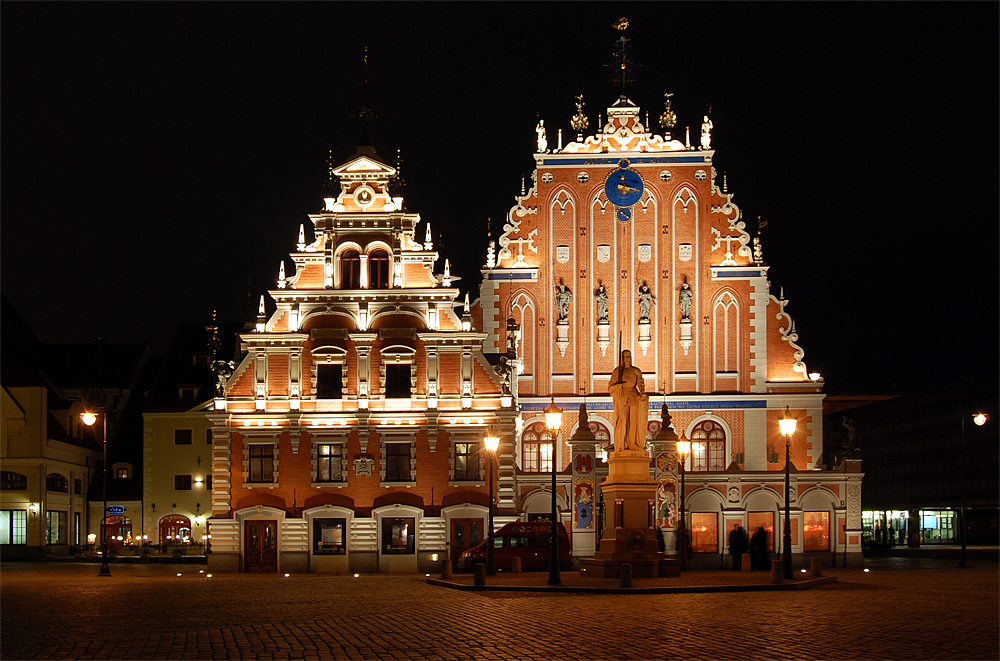Нouse of Blackheads is the famous monument of architecture of 14 century, situated in the Centre of Riga. Tunable on several occasions the building was mostly destroyed during the years of the great patriotic war. Restore the building was already in our days.
In historical records the first building is mentioned in 1334 as the new home of the great Guild Hall, and was built during the time of the award of the occupation in the period 1330-1353 years. At the end of the fifteenth century the building was leased to the Černogolovym and was called in those days as "King Arthur's Court", the current name of the House was probably in the late 60 's 16veka.
Blackheads are a fraternity, consisting of young and unmarried foreign merchants. The brotherhood has existed since the end of the thirteenth century and is under the patronage of St. George, patron of the brotherhood but later became St. Mauritius, whose symbol is a black head in the coat of arms and has become the hallmark of the fraternity.
The founders of the richest and most influential company representatives not only in Riga, but also foreign companies involved in the direct delivery of goods in Riga. They have created a company of blackheads as opposed to the large Guild settled merchants of the city of perekupkoj goods. But, despite the separation, the company still was under the supervision of the great Guild Hall until the end of the seventeenth century.
According to historical data from 1477 onwards Blackheads rent house, built for public use by the Guild of craftsmen. Decorating and redesign the building, Blackheads over time become the sole owners of a new home. The first half of the day the building works as a stock exchange, and the afternoon is devoted to recreation, it hosts various evenings, balls, and concerts, so much so that the wonderful acoustics.
At different times there have been in this House and apparently and secretly Russian tsars and tsarinas. Portraits of the monarchs of Sweden and Russia served as a decoration of halls, among them is the portrait, personally donated by Catherine the second. So in the book of honorable guests, among the many entries there is a signature of the Bismarck.
Along with the Large Guild organization led a public life of the city, took an active part in the defense, and by the end of 1895 was the Club of the German merchants, ceasing its operations as a corporation. And since 1939, the Germans closed after the repatriation.
The original House, unfortunately, is not known. The building covers an area of 425 sq.m., the main part of the House of blackheads is the Central Hall. The Hall was divided into several rooms and a small cellar underneath. Loft House served as a storage facility. Despite repeated restructuring and changes the entire House-intact remained the Hall, as the core of the building, which is a historical value.
Today's appearance of the façade was completed in the beginning of the 17 century in the style of European Mannerism. According to Professor Vippera, the authors of the architecture of the building to look for among the masters of Bremen, Danzig and Denmark. These days, scientists suggest it or Ânseny Bodeker. The façade is decorated with sculptures, finishing is made with the help of artistic forging, another jewelry-watches. The House of blackheads are the unique astronomical clock with mechanism of "perpetual calendar". Three of the clock face apart from the time show number, month and year, as well as the time of sunrise and sunset and moon phase. In the museums of the history of Riga and navigation, as well as the architecture of the different pieces of the Museum building and parts of the interior decoration of the House of blackheads.
In 1684, they added a porch, through which you can directly from the square to get to the second floor. Another two-story extension was built in 1794 and 1816, another year, but already by the river Daugava. In the same years was replaced by an open porch covered entrance. The most recent and, perhaps, a significant change in the façade have brought the statue of Neptune, Mercury, unity and peace, made of zinc and established in the year 1886.
In 1941, in June, the House came under fire by German troops, its ruins stood until 1948 year. In place of the dismantled ruins the blackheads House instead of Town Hall square has an area of Latvian Red riflemen with a Museum and a memorial to the Latvian Red Riflemen. After Latvia regained its independence, the area once again became known as the Town Hall and the Museum was renamed the "Museum of the occupation of Latvia".
Originally did not intend to restore the House of blackheads, but to the 800-year anniversary of Riga, it was rebuilt. Before him stands a statue is a symbol of freedom, the judiciary and the protection of trade, as Roland. In the House in our DNA is a Museum and concert hall where concerts of symphonic music.










